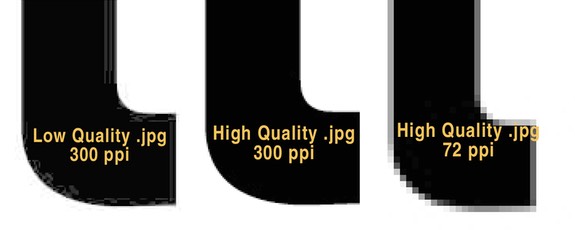An image is an image, right?
Well, maybe!
Did you know: when you see an image (either a graphic or a photo) on the web, in most cases it will have a resolution of between 72 and 100 ppi (pixels per inch, but more commonly referred to as dpi - dots per inch - which is incorrect but a whole 'nother article!).
This is the standard for two reasons: 1) that's the highest resolution that can be seen on a monitor, and 2) it makes the file size smaller.

Photos and other print media using digital files, have a minimum requirement of 300ppi / 300dpi, which allows for fine details to be printed. This minimum resolution not only applies to paper printing, it even applies to such imprintable items as tshirts, mugs, pens, banners, etc.
In most cases when viewing images on a monitor at actual size, you will not be able to see a difference between a 72ppi version of an image and a 300ppi version. You will see a difference if you zoom in or you print both images on a professional grade printing press using quality paper (used for photographs, magazines, brochures, etc).
You can, in some cases, take a 72ppi image and turn it into a 300ppi image successfully using Photoshop (and possibly other graphic applications)...however, there are some caveats:
1. When opened the image must be very large
2. The image must be high quality with no artifacts, pixels, or halos visible
The best way to determine if your image will be successful in converting from 72ppi to 300ppi is to open the image, note the dimensions in inches, take each number and divide by 4 and that will be very close to the actual size of your image when converted.
For example, I open a digital photo and it is 20 x 28 inches with a resolution of 72ppi, divided by 4 gives me a 300ppi size of 5 x 7 inches. A more common example is a 3 x 4 inch, 72ppi image, retrieved off of a website, it would have a 300dpi size of about 3/4" x 1 inch...not suitable for any print job.
Photoshop does have the option to "convert" an image from 72ppi to 300ppi while maintaining the existing size of your image. Unfortunately, during the interpolation it will magnify any existing artifacts or damaged areas rendering the image unsuitable for high quality printing.
As odd as it may seem, it is possible, if you do not know what you are doing, to have a high resolution (300ppi), poor quality (artifacts, blurriness, pixelation) image.
If you do have a small, high quality image that you need to have enlarged, it is worth the small cost to find a company, such as Puffin Enterprises, that has professional software, experience and skill to do it for you.
Related Articles: